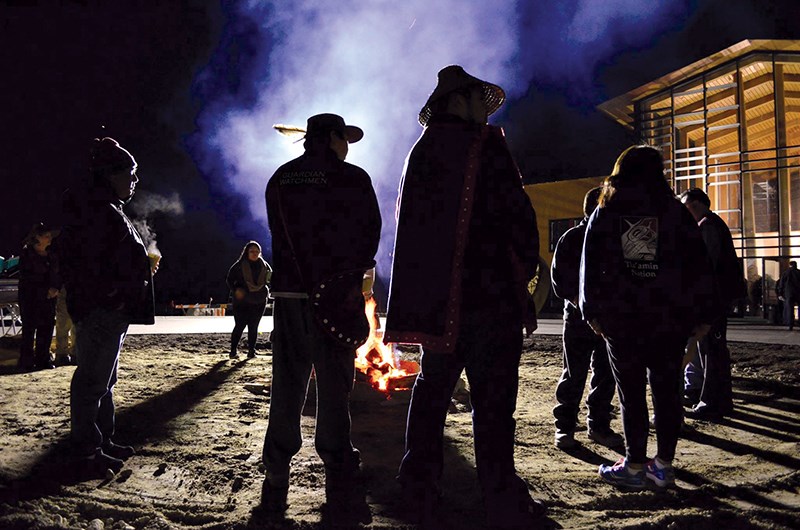Tla’amin Nation’s treaty implementation has been selected as the top news story of 2016 by Powell River Peak editorial staff.
Out of all the stories covered in the newspaper’s pages this year, nothing quite compares to the gravity of what happened for our Tla’amin friends and neighbours one minute after midnight on Tuesday, April 5, when the provisions of their long-negotiated treaty became enacted as law.
Ashes from burned Indian Act pages, federal legislation that, up until that night, had dictated the relationship between Tla’amin and Canada, fell from the sky, collecting on the ground of a new self-governing first nation with its Government House illuminated by the glow of the bonfire; a gesture engulfed in symbolism.
“This is a day of triumph for all Tla’amin people,” hegus Clint Williams told a crowd of people, both aboriginal and non-aboriginal, who gathered that night for a celebration that included singing and dancing. “I’m proud of my community for choosing a path of change, that while difficult at times, provides us with a new beginning as a self-governing nation free of the Indian Act.”
Later, at an early morning legislative session, Tla’amin lawmakers passed provisions for the nation’s self-government, land and capital transfers.
Community ceremonies for the treaty implementation, including the unveiling of totem poles, were held on Saturday, April 9. Federal minister of indigenous and northern affairs Carolyn Bennett and BC minister of aboriginal relations and reconciliation John Rustad were invited.
Bennett said Tla’amin’s self-government is a hope for many first nations around the country.
“It is truly momentous and such an example for Canada,” said Bennett. “This aspiration for self-government is really what everyone is hoping to achieve from coast to coast.”
Bennett added that she was pleased to be able to attend the ceremony.
“This really is a very exciting day,” she said. “It warms your heart to see the excitement as people get in charge of their own lives. It’s spectacular.”
Rustad said the implementation of the treaty was a big step for the Tla’amin people.
“The province is extremely proud to be a partner with the Tla’amin as we move forward building a future with them,” he said.
Williams noted the symbolic importance of the six totems unveiled that day.
“One of the main reasons we had this vision was to make a statement as we enter into self-government,” said Williams. “The Indian Act did not define us or make us Tla’amin people, the Indian Act just made us indians.”
Williams said carvings on the poles serve as a symbolic reminder of strengthening Tla’amin identity through the rediscovering and spreading of his people’s language and culture.
“This is the symbol we will take on those challenges and improve the lives of all Tla’amin people,” he said.
The three welcoming poles depicting father, mother and child symbolize the nation’s openness and acceptance. Three other poles depict the past, present and future of the people.
The totems were carved from red cedar logs, gifts from Klahoose First Nation and harvested from Toba Inlet, about 100 kilometres northwest of Powell River.
The totem unveiling was one of two ceremonies that day. A community celebration in Evergreen Theatre at Powell River Recreation Complex, em-ceed by Tla’amin actor, writer and physician Evan Adams, featured speeches, song and dance, gift exchanges and presentations that ran through the afternoon. Ministers Rustad and Bennett were also in attendance for part of the second ceremony.
Tla’amin’s chief treaty negotiator Roy Francis, who devoted more than 20 years of his life to pursuing the nation’s independence, said in an interview prior to the community event that the buildup to treaty implementation in the days prior to April 5 had been a mix of emotions.
“There has been sadness for members of our community who are no longer with us, happiness for our young people, whose future we know is going to be different, and excitement for the community that was able to witness the event with us,” said Francis.
Tla’amin Nation’s agreement received final federal approval in June 2014, though it did not come into effect for almost two years, giving the nation time to prepare. According to the federal government, the agreement brings certainty to the nation’s aboriginal rights, land title, and provides economic benefits. The deal includes 8,300 hectares of land, approximately $30 million and self-government, among other provisions.
A foundation of the work that went into establishing Tla’amin’s case for its traditional lands, and critical to the success of the project, was the testimony and stories of elders who shared their memories of the way their lives were when they were young. The majority of those who helped did not live long enough to see the treaty implemented.
Francis was one of several people who, in the early 1990s, started a community conversation, instigated by former chief Eugene Louie, about what the future could hold.
A decision was made in 1994 to enter into the BC Treaty Commission process. It would take 16 years and thousands of hours of work before federal, provincial and Tla’amin negotiators reached an agreement on the essential elements of the draft final agreement.
Many challenges were overcome during the process. Francis said the agreement is directed at the future and provides “security we never had before with a land base we have title to.” He added that the agreement will have a positive impact on the region as a whole.
“Something that’s good for Tla’amin is going to be good for Powell River,” he said. “It’s going to be good for our neighbours. Our kids go to the same schools. We go to the same grocery stores. Tla’amin is going to be a bigger part of the economy and that’s going to be good for the whole area.”



